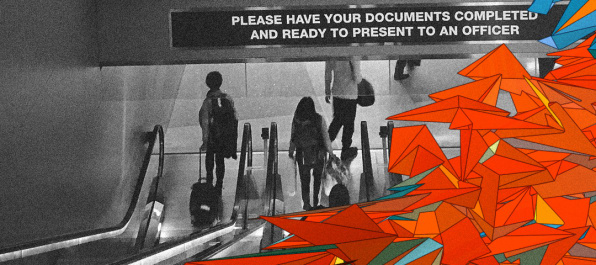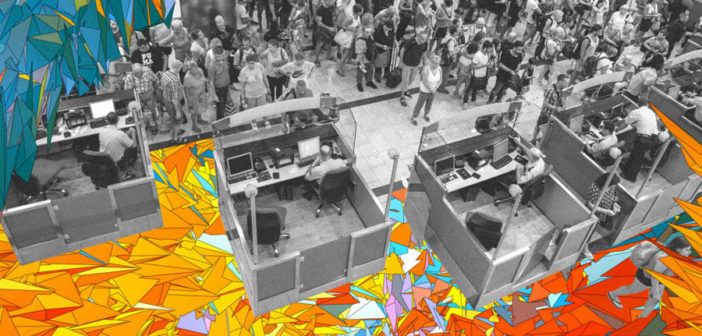Sometimes changing three lines in an FAQ qualifies as a rousing success, writes Hana Schank in the fourth installment of The Government Fix.
This is the fourth installment in The Government Fix, a new series on redesigning how government works, published in partnership with the nonprofit think tank New America. –Eds.
I joined the United States Digital Service because of the jaw-dropping success stories. Saving healthcare.gov and bringing medical insurance to an entire nation? Sign me up! Fixing refugee admissions to save 10,000 Syrian refugees from a brutal regime? Well I wanna do that, too. My plan, when I arrived, was to ride in on my white horse, my arsenal stuffed with Post-it Notes and well-researched prototypes and GitHub repos and help save government. The stories made that seem like a reasonable goal.
Soon after I arrived in Washington, D.C., I saw my chance. Customs and Border Protection (CBP) needed our help. They were looking to redesign the application for their Trusted Traveler programs–if you’ve been on an international flight in the last 10 years you might be aware of Global Entry, but there are actually multiple programs that help speed your time coming through customs and passport control into the United States. The application was unwieldy and old. It took hours to complete. And even worse, the backlog was months long. All of the Trusted Traveler programs required an in-person interview with a CBP officer, but high demand and minimal staff meant that in some cities, applicants had to wait nearly a year for their interviews. For people who were hoping to use Global Entry on their business trip to Hong Kong next month, or to make their upcoming vacation to Mexico a little easier, this wait validated everything they already thought about government. Government is slow. Government makes you wait. Government doesn’t really care about people.

While fixing the Trusted Traveler programs might not seem on par with saving Syrian refugees, I saw it as an opportunity to help repair some of the front lines of citizen-government interactions. There are only a few places where we, as citizens, come face-to-face with the physical manifestation of government. The airport is one of those places. And those interactions are usually miserable. They involve long lines snaking through a TSA checkpoint when you just want to get to your gate. They mean coming off an exhausting international flight only to find yourself trapped in the windowless bowels of JFK Airport, propping your jetlagged self up against the wall, straining to see the end of the line, wondering if this as possibly the third ring of hell, while waiting to get your passport stamped. The TSA and CBP officers are usually brusque. Sometimes they yell at you.
So I jumped at the chance to work on the Trusted Traveler program. Sure, we told CBP, we would redesign their application; we’d use an agile process, we’d speed up the development timeline, and we’d make it the agency’s first cloud-based application. But we also wanted to take a peek into the backlog. We wanted to evaluate the entire application process. Because the application was only one small part of applying for a Trusted Traveler program. There was also the decision to apply. The selection of a program. The months-long wait. The interview. We wanted to look at all of it. We wanted to change ALL OF THE THINGS.
Ever eager, my team began to dig into the larger application process. We spent time observing the interviews at a Global Entry registration center, and discovered that most people who showed up to the interview weren’t entirely sure what they were registering for. The biggest confusion was between Global Entry and TSA Pre-Check (a separately administered program whereby you do not have to take your shoes off or pull out your liquids when going through security). This was entirely understandable from the traveler perspective, because both are programs offered by the government that help you do something at the airport. And to make things even more confusing, if you sign up for Global Entry, they throw in Pre-Check for free. But if you enroll in Pre-Check, you don’t get Global Entry.
So we watched one person after another arrive at the Global Entry interview and ask if they were also being enrolled in Pre-Check, or puzzle over what they were getting with Global Entry, or try to determine if they’d made the right decision in opting for the more expensive program. Imagine waiting eight or nine months to interview for a program that you don’t fully comprehend.
As we passed the day at the Global Entry enrollment center the team got excited. This seemed like a fixable problem. But we wanted to validate it with additional research. So we returned to USDS HQ and spent a day pulling people in front of a computer and asking them to figure out if there were any government programs that could help them at the airport. We quickly learned that people outside of the Global Entry enrollment centers were even more confused than those who had managed to sign up for an interview. People were Googling things like “get through the airport faster.”

But the biggest point of confusion was around which program–Global Entry or Pre-Check–could be used for international travel. This confusion was exacerbated by the Pre-Check FAQ, which people would make their way to after typing in “Can I use Pre-Check internationally.” The FAQ read, “Yes. TSA Pre-Check is available when you depart from a U.S. airport to a foreign country.”
Technically, this was correct. When you are flying out of O’Hare and heading to Paris, you can use Pre-Check so you don’t have to take your shoes off en route to the gate. But this didn’t answer the question people were really asking, which was when I return to the country, will Pre-Check help me? And to that, the answer was no. You cannot use Pre-Check to get through customs faster.
So several months of research had led us to the discovery that while we might want to change ALL THE THINGS, the first thing that needed to be changed was actually three lines in an FAQ. And several weeks, phone calls, and meetings later, TSA changed the FAQ. Not only that, they added a link to the Global Entry program, which hadn’t been there before.
The day that the FAQ change went live, I wanted to pop open champagne and run screaming “WE DID IT” through the streets of Washington. It felt ridiculous–it was such a tiny, tiny change compared to all the things we’d hoped to fix–but it was a change that could potentially help millions of travelers, and it was also, we hoped, the first step toward even bigger changes.
Even so, I felt a bit embarrassed that after months of work all I’d accomplished was changing three sentences in an FAQ. I was used to big, splashy launches and product rollouts with lots of fanfare. But the truth is that while we may all love the big, splashy stories, the majority of innovation and modernization in government doesn’t look like that. That is, I was not wrong in wanting to celebrate a small victory. In our research we found that the landscape is dotted with these small successes. They don’t get a lot of media attention. They may not result in a champagne party, but they should.

The U.K.’s Behavioural Insights Team (BIT) is one organization that actively looks to solve for big questions by making small changes. In 2012, the team was working with the tax authority in the U.K. on the enormous question of how to get people to pay their taxes on time–in particular those who have already fallen behind. For years, the tax authority had sent a standard government form letter, stating the letter of the law and asking people to send in payment. Since the authority was already communicating with taxpayers via letter, BIT decided to see if they could alter the wording to bring in more tax payments, rather than creating an entirely new process. After multiple rounds of research, they determined that the most effective solution would be to add a single sentence to the letter: “The great majority of people in your local area with a debt like yours have paid it by now.” (The shame!) That one change–that single sentence–brought in over 210 million pounds of revenue in a single year.
“Traditionally in the public sector you’ll look for big bang answers to those big bang questions. So, you’ll look at ‘What’s the new policy,’ or ‘What’s the billion-dollar new investment that we can make?’” Sasha Tregebov, a senior advisor at BIT’s North American office, told me.
“We’ve done now, as an organization, perhaps thousands, of projects where we test small changes to language and process to help people make better choices and support a diverse set of social impact goals. Small changes can help us get there.”
And in Durham, North Carolina, the city’s innovation team has been looking to make small changes as they work to improve outcomes for residents returning from prison. It’s a multi-tentacled challenge with a hazy endpoint. So the team thinks about small problems they can solve for in the short term, as they hack away at the larger issue. They began with months of research and interviews with the politely termed “justice-involved residents.” In their interviews they heard consistently that when people return home from prison, they often lack valid driver’s licenses, which leads to a whole host of difficulties when it comes to reintegrating with the community. They’ll often drive with revoked licenses, get caught, and go back to jail. Or they can’t get a job because they don’t have a license. Or they can get a job, but they don’t have any way to get to work because they can’t drive. So the team looked into how many people in Durham County had suspended or revoked driver’s licenses; the number was 46,000. (Durham is not unique–this is a national problem.)

Keeping the idea of small steps in mind, the team started with text messages. From their interviews, they knew that the last place you want to go if you’ve just returned from jail is the courthouse. So they worked with the District Attorney’s office to create an amnesty day, and allowed residents with license problems to text their information to see if they qualified to have their license reinstated. They figured they’d get maybe a hundred text messages. Instead, over 2,200 people texted.
“That was somebody’s cell phone on the team,” recalled Josh Edwards, the innovation team director. “We basically had to give it up and just make it the amnesty phone.” The team was able to help 700 people with their driver’s licenses. They are now refining the idea, and working with Code for Durham, their local Code for America brigade, to develop a software solution to help bring the process online. A small step, leading to a larger one, each building on what came before. This approach is the opposite, perhaps, of moving fast and breaking things. Instead, the focus is on piecemeal, methodical changes, each one adding up to part of a larger whole.
Similarly, for Customs and Border Protection, the FAQ change was not the end of the line. We later went on to relaunch the Trusted Traveler application. We built a tool to help travelers figure out which program was right for them. We didn’t get to work on reducing the backlog, because sometimes you don’t get to do ALL OF THE THINGS. But the things we did do likely helped millions of travelers around the globe.
In her book Slow Medicine, Victoria Sweet explains how the Slow Food movement of the 1980s and ’90s influenced her thinking around how to practice medicine. “Slow Food was about process, I gradually understood. Even with the best ingredients you can’t have a good meal if all you focus on is product, the result. . . . Slow food was local, individual, relational.”
Sweet is one of a number of physicians who have taken the concept of slow food and applied it to medicine. She began spending more time sitting with her patients, listening to them, understanding their conditions and complaints in the context of their lives. She chose not to rush to prescribe medication or interventions, letting time take its course as appropriate.
Similarly, in government, teams are using a Slow Medicine/Slow Food approach. They are looking holistically at problems, taking time to solve the small things individually. Pausing before rushing into a solution. Sitting with the patient. Using what we can perhaps call ‘slow innovation.’ They are not breaking anything. They are repairing, bit by bit, celebrating quietly and then getting back to the work.
–
This article first appeared in www.fastcodesign.com
Seeking to build and grow your brand using the force of consumer insight, strategic foresight, creative disruption and technology prowess? Talk to us at +9714 3867728 or mail: info@groupisd.com or visit www.groupisd.com



